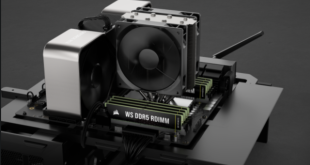Most of the time, technology manufacturers keep the underlying cost of a product ‘masked' from us, the consumers. When a component suffers a temporary increase in cost, that amount is swallowed and the price on the shelf remains the same.When the price drops, the manufacturers also hang onto the difference as ‘increased profit'. Memory has been fairly linear for a while, but we've noticed something recently and wanted more explanation. Fortunately the world's biggest memory companies were on hand to help.
Over time, better and better components get sold for less and less.
That's the way of the tech world.
In a computer store over the weekend, one of our operatives got into a conversation with a customer who was pondering whether to buy a GTX660 or the Ti version. They decided to do some ‘on the spot' research, so smartphones were used to access various charts created by KitGuru Labs over the last 12 months – and the customer went with the Ti.
During the discussion, the option of moving up to the GTX670 was discussed, but the benefit Vs cost jump was considered ‘too much'.
You get these ‘quantum leaps' in all product stacks. Points where the move from one option to the next is significantly more expensive.
Right now, we seem to have that kind of situation bubbling with the move from 16GB to 32GB of memory.
Going from 2GB to 4GB, 4GB to 8GB or even 8GB to 16GB – gives you a linear/predictable increase of around 100% for each jump.
But when you move from 16GB to 32GB, it can increase by close to 150%.
Bizarrely, going from 32GB to 64GB seems to bring the increase back down toward a straight 100%.
We spoke with Alex Rüdinger, marketing guru over at ADATA, the world's second largest producer of memory modules. He told KitGuru, “It's to do with restricted supply on the 512×8 modules. Pricing for these won't fall until there is a substantial increase in volume shipment. As the market demands more 512×8, so the price will fall”.
We also managed to speak with Bernd Dombrowsky from Kingston, the world's leading memory module manufacturer. Bernd is not only a marketing guru, but also sales and PR. He went a little deeper with KitGuru.
“Memory modules, as well as USB sticks and Flash memory cards are built with a printed circuit board (PCB) and a number of small components, like resistors. They all add a few cents to a couple of dollars to the overall build cost”, he explained.
“The most valuable item in the Bill Of Material are the actual DRAM or NAND memory chips which add 90% and more to the build cost”, he continued. “If you compare specific capacities, then in most cases you're actually comparing products where the higher capacity simply has double the number of the same memory chips soldered onto the PCB”.
For example Bernd?
“Well, you can build a 2GB [Giga BYTE] module with eight pieces of 2Gb [Giga BIT] chips. Similarly, by soldering sixteen pieces of the same 2Gb component onto the PCB you can build a module with 4GB capacity. However, if you want to build a 8GB or 16GB module there simply isn't enough space on the board to solder 32 let alone 64 pieces of these chips on”, he told KitGuru. “You therefore have to build with 4Gb components”.
“The prices for 4Gb, compared to 2Gb components, are approximately double at the moment so you don't notice immediately in the module price that the components used are different”, said Bernd. “Not so long ago 4Gb components demanded a noticeable premium as they required the latest and greatest production technology in chip manufacturing, for example the latest die-shrinks etc. Market prices will allow for a premium until a particular die becomes a mass produced commodity”.
Bernd concluded by telling us, “Today, you've noticed that the biggest price change happens when comparing 16GB to 32GB memory modules. The 32GB products have to be built with 8Gb components as opposed to the 4Gb used on smaller modules. These 8Gb chips are amongst the newest and most advance discrete memory devices (chips) available. Once production volumes and yield rates increase for these state-of-the-art chips, the price gap will narrow – as it has done with other memory densities in the past”.

.
KitGuru says: So, we have agreement between our experts, with the situation neatly summerised by Alex and explained in depth by Bernd. KitGuru remembers when a 5MB Winchester Drive was used to index the entire contents of a library (and a god to be worshipped), so the idea that desktop memory will increase beyond 64GB in the future has us a little staggered. But we all know it will happen as systems increasingly blur the line between the various storage media.
Comment below or in the KitGuru forums.
 KitGuru KitGuru.net – Tech News | Hardware News | Hardware Reviews | IOS | Mobile | Gaming | Graphics Cards
KitGuru KitGuru.net – Tech News | Hardware News | Hardware Reviews | IOS | Mobile | Gaming | Graphics Cards


